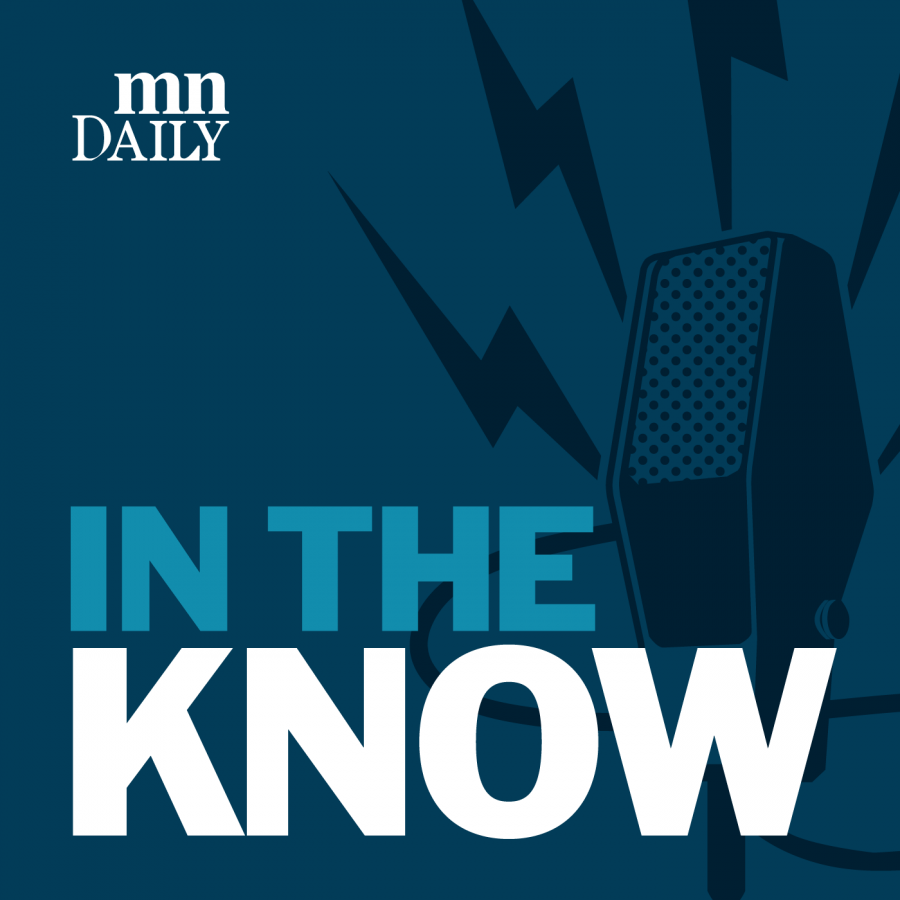NICK ESTES: It’s a settler colonial problem.
CROWD: That’s right.
ESTES: It’s a capitalist greed problem.
So remember that, that it’s everyone’s problem. This isn’t an Indian problem. This is everyone’s problem. So thank you all for coming out tonight.
ALBERTO GOMEZ: On Friday, March 17, the American Indian Student Cultural Center and Students for a Democratic Society held a protest outside of Humphrey Hall.
HANA IKRAMUDDIN: They had a few demands for the University of Minnesota, mostly that looked like expanding the Native American Promise Tuition Program. That also looked like increased support for the American Indian Studies Department and the creation of a liberal education requirement in American Indian Studies.
GOMEZ: There were a little over 30 protestors attending, but Hana ended up counting 32. Uh, there were also a handful of guest speakers ranging from community members, professors, and, of course, students as well.
IKRAMUDDIN: Hi everyone. My name’s Hana Ikramuddin,
GOMEZ: And my name is Alberto Gomez, and this is In The Know. So Hana, you mentioned a program called the Native American Promise Tuition Program. I’m a little lost. Can you break that down for me and for our listeners too?
IKRAMUDDIN: Yeah, definitely. So the program was announced a little over a year ago, and it’ll go into effect in the fall of 2023. It’s an attempt to cover tuition for Indigenous students at the University, but there are a few qualifying factors that students need to meet before that. First, students need to come from households that make less than $125K. They also need to be enrolled in one of the 11 federally recognized tribes in Minnesota.
GOMEZ: Seven of which of those tribes are Anishinaabe and another four are Dakota.
IKRAMUDDIN: Students also need to complete the FAFSA. They need to enroll in the program as a freshman or a transfer student from one of the four tribal colleges. They also need to take a minimum credit load.
GOMEZ: It’s also worth noting that the average Native household makes only about $50,000 a year. This program does not apply to tribal nations that have been displaced from their historical homeland.
So Hana stated earlier that the tuition program only applies to freshmen and transfer students from tribal colleges, and that means that it doesn’t qualify to second-year students, doesn’t qualify to third-year, fourth-year, any native student that is already registered at a University of Minnesota school. But that’s not the main reason that advocates are upset right now.
IKRAMUDDIN: That mostly comes down to the number of students getting support from the University on this program. Eighteen out of 146 Native freshman students are getting tuition support from the program, according to a December Star Tribune article. That’s across four different campuses: Crookston, Duluth, Rochester and the Twin Cities.
GOMEZ: Merlin Valenstine, who attended the protest, talked to us about how important boosting the Native student population is.
MERLIN VALENSTINE: I think everybody should have the access to education, and again, it’s, we’re living on Native land. I think that we should be fighting for their rights as well.
IKRAMUDDIN: Anthony Taylor-Gouge, who’s a student in the American Indian Studies Department and spoke at the protest, also talked to us about the importance of capturing the University administration’s attention on these issues.
ANTHONY TAYLOR-GOUGE: We wanna make sure that, uh, that the University is listening, uh, but more than anything, like they actually materially do something, um, which I think is like the big thing that, like the University is not really good at.
GOMEZ: Alessia Guzman is not a Native student, but a Latiné one, and they showed up at the protest because they feel the University is not doing enough to support Native and POC students.
ALESSIA GUZMAN: I want, um, people to be more aware of the issues that the American Indian students are dealing here like on campus. I would like to see the U of M to actually keep the promises they’re making and actually just do the things they say they’re doing and actually be progressive as much as they say they are.
ASSORTED VOICES: Native lives, they matter here.
Native lives, they matter here.
Native lives, they matter here.
Native lives, they matter here.
IKRAMUDDIN: Laila Gourd, the University outreach coordinator with AISCC, told us that the group met with Senior Advisor to the President for Native American Affairs, Karen Diver, this month. They discussed some of these demands, and they hope to keep pushing for the expansion of the program.
We got an interview with Laila, but the tape came out warbly and Alberto couldn’t repair it, so we aren’t including it here.
GOMEZ: Funding from the state might also be on the way. [Gov. Tim] Walz also included the plan in his newly released budget request, which would give Indigenous Minnesota residents a tuition and fee waiver as long as they’re enrolled members or citizens of any federally recognized American Indian, Canadian First Nation tribes or citizens of a Minnesota tribal nation.
IKRAMUDDIN: The University also sent us a statement that mentioned that this program does not represent completed work. They said that from its inception, U of M leaders have emphasized that the program’s launch was a hopeful first step on a path toward increasing access and support for Native American students.
GOMEZ: Notably, Indigenous students make up one of the smallest racial or ethnic groups at the universities. There are about 1,500 Indigenous students across all five campuses.
TAYLOR-GOUGE: Like I don’t think it’s like asking that much to, to, you know, fund a $50,000 tuition.
Um, for students who, um, whose families and ancestors and relatives were dispossessed of land and exiled from, from their homelands.
Like, I don’t think we’re asking for that much.
GOMEZ: We wanna acknowledge that this episode’s a little different. Hana and I wanted to try an experiment with a different kind of structure and execution for this kind of story. So let us know what you thought, and feel free to email us at [email protected]. Thank you very much for listening.
My name is Alberto Gomez.
IKRAMUDDIN: I’m Hana Ikramuddin, and this is In The Know.



